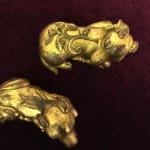A Pair of Ming Gilt-Bronze Ram Figure Paperweight, 15th Century CE - 16th Century CE
3 x 2.5 x 1.5
HK.5120
Chinese scholar’s objects were, in a sense, the luxury goods of their time, but rather than wealth what they really represented was the physical embodiment of the scholar’s intellectual curiosity...
Chinese scholar’s objects were, in a sense, the luxury goods of their time, but rather than wealth what they really represented was the physical embodiment of the scholar’s intellectual curiosity and aesthetic taste. The history of the literati scholar in China dates back to the Tang and Song dynasties (AD 618-907 and AD 960-1279, respectively), when the court implemented meritocratic civil exams for the selection of bureaucratic officials. The tests assessed the candidates’ knowledge and ability in a wide range of subjects, including Confucian thought, law, agriculture, and the arts, especially calligraphy, painting, and music. As such, an entire class of intellectual and artistically trained scholars was created.
This pair of gilt-bronze paperweights are depicted in the form of two rams. One being the mother, who turns back to look closely at her son, while another being the son, distinguished by its smaller size and the presence of goat-moustache. The facial expressions of the animals are finely carved, while the flow of lines along their body is refreshing. These two items would have been used to weigh down a paper scroll, allowing the scholars to quietly reflect on the contents written.
This pair of gilt-bronze paperweights are depicted in the form of two rams. One being the mother, who turns back to look closely at her son, while another being the son, distinguished by its smaller size and the presence of goat-moustache. The facial expressions of the animals are finely carved, while the flow of lines along their body is refreshing. These two items would have been used to weigh down a paper scroll, allowing the scholars to quietly reflect on the contents written.



